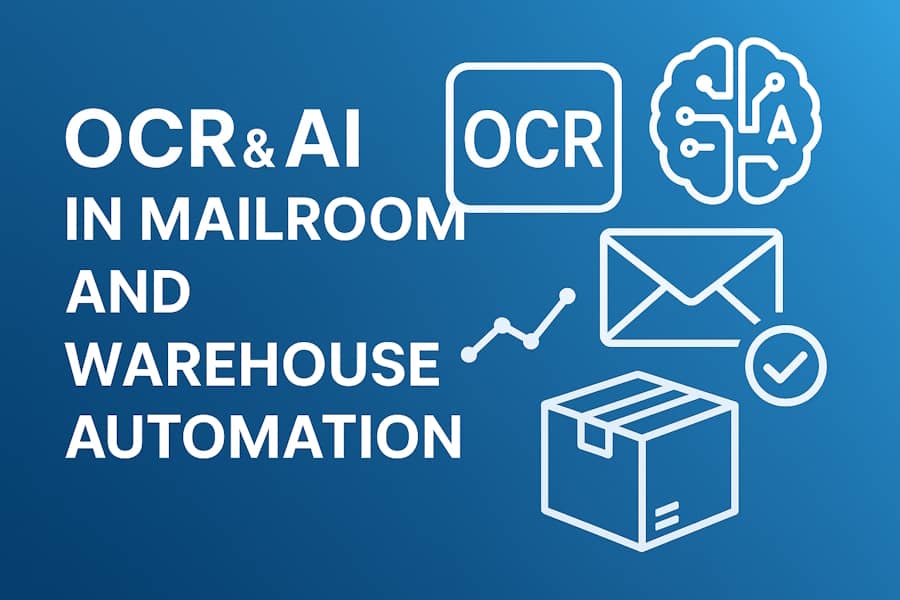Warehouses and mailrooms have long been centers of repetitive tasks, unpredictable backlogs, and lost items. With parcel volumes at record highs and customer expectations around delivery speed increasing, traditional manual processes can no longer keep up. Optical character recognition (OCR) and artificial intelligence (AI) are stepping in to modernize these workflows.
Together, OCR and AI help businesses reduce human error, process data in real time, and automate logging at a scale that was previously impossible. These technologies now form the foundation of the latest generation of parcel management software solutions.
Volume and Complexity Are Outpacing Manual Processes
Incoming parcels often arrive with inconsistent labeling, faded barcodes, or handwritten notes. Warehouse and mailroom teams are expected to recognize the contents, log delivery details, alert recipients, and track each item throughout its journey. At high volume, this becomes unmanageable without automation.
OCR solves this by reading printed or handwritten text from shipping labels, delivery manifests, and damaged tags. When combined with AI, it not only reads the data but also understands its meaning and where it belongs in the process.
“Automation no longer means just faster. With AI, it means smarter, more accurate, and more scalable.”
What Happens When OCR Meets AI?
Here’s how the combination of OCR and AI delivers measurable improvements in mail and parcel handling:
|
Feature |
Impact on Operations |
|
Data extraction at scale |
OCR reads thousands of labels per hour, regardless of layout or print quality. |
|
Context-aware classification |
AI identifies whether a package is personal, confidential, or bulk based on learned patterns. |
|
Error reduction |
The system flags duplicates and inconsistencies that human eyes often miss. |
|
Live status updates |
As soon as a package is scanned, recipients and departments receive instant notifications. |
|
Smart routing |
AI determines the fastest and most efficient delivery path within large buildings or campuses. |
This approach allows modern mailroom and parcel management systems to operate with near-zero error rates. Instead of relying on staff to manually log every item, OCR and AI handle the heavy lifting while staff focus on oversight and customer service.
Mailroom Efficiency Without the Bottlenecks
In large organizations or multi-tenant buildings, hundreds of deliveries may arrive daily. Logging these manually takes time and introduces unnecessary errors. The most advanced mailroom management software solutions use OCR to scan delivery labels as they arrive and automatically record them in the system. AI then compares this data against staff directories or tenant lists to trigger notifications instantly.
For warehouse operations, OCR and AI speed up package intake, streamline dispatch, and reduce turnaround times. Integrations with internal databases allow teams to locate parcels faster and handle exceptions more efficiently.
Here’s what the shift looks like in measurable terms:
|
Metric |
Before OCR + AI |
After Implementation |
|
Logging time per parcel |
1–2 minutes |
10–15 seconds |
|
Manual data entry error rate |
2–3% |
Less than 0.1% |
|
Package location resolution time |
15–30 minutes |
Real-time |
“OCR and AI reduce logging time by more than 75 percent while increasing accuracy dramatically.”
Scalability and Adaptability
One of the biggest advantages of AI-powered systems is scalability. Unlike manual processes that require additional staff during peak periods, automated systems can handle spikes in parcel volume without slowing down.
These systems also learn over time. The more data they process, the better they become at identifying delivery patterns, anticipating recipient behavior, and flagging potential issues before they escalate.
For example, if a department consistently receives temperature-sensitive shipments, AI can automatically tag those deliveries as high-priority and ensure they are routed or stored correctly.
Building Intelligence into the Last 100 Feet
In both mailroom and warehouse operations, the final stretch of delivery, from intake to recipient, is a critical window for delays and errors. AI closes this gap through features such as:
- Smart notifications that alert recipients via email or app
- Real-time dashboards showing inbound and outbound parcel flows
- Searchable archives for past deliveries, signatures, and proof of collection
- Automated reminders for uncollected or delayed packages
These capabilities are powered by OCR at the point of entry, which provides clean, structured data that AI can interpret and act upon.
For teams managing hundreds or thousands of deliveries per day, this shift changes everything. Staff no longer chase missing parcels, recipients get timely updates, and facility managers maintain complete visibility.
Choosing the Right Technology
When evaluating solutions, look for a mailroom management system that includes integrated OCR and AI capabilities. Choose platforms that can scale with your needs, offer configurable workflows, and include analytics for continuous improvement.
These platforms combine automation with intelligent data capture, helping organizations modernize their mail and parcel handling without large hardware investments or additional staff.
A Smarter Path Forward
AI and OCR are not just technical upgrades. They represent a fundamental shift in how mailrooms and warehouses manage information, accuracy, and time. Together, these technologies eliminate inefficiencies, enhance visibility, and allow staff to focus on higher-value tasks.
As delivery volumes rise and expectations for accuracy grow, businesses that adopt these systems today will be better positioned to meet tomorrow’s logistics challenges. Intelligent automation is no longer a luxury. It is becoming the foundation of efficient, data-driven parcel and mailroom operations.








